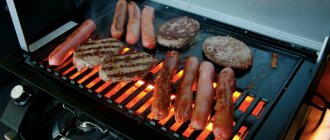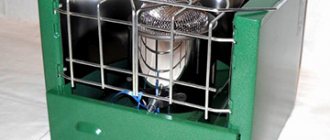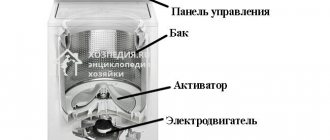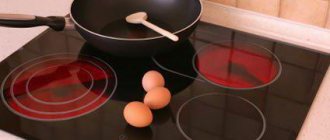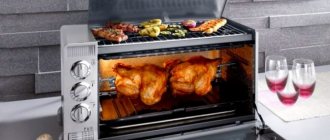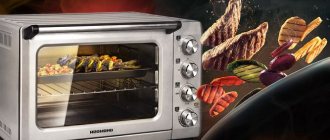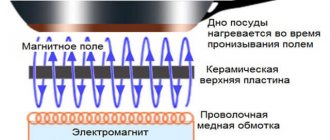Humanity has been cooking food for thousands of years, but only relatively recently did housewives get an electric stove. The device has several varieties and opens up great opportunities for both culinary masterpieces and kitchen design.
What is an electric stove?
In the middle of the 19th century, an English inventor gave the world a gas stove that changed the lives of millions of housewives all over the planet. By the end of the century, its modification also appeared - the electric stove. This household appliance is designed for cooking or heating food in private homes, apartments, catering establishments and other establishments. As the name implies, an electric stove operates only when connected to the power supply network, transforming current into thermal energy.
Operating principle of an electric stove
Home appliance stores offer a large selection of different models of cooking devices, but all electric stoves have a similar operating principle:
- An electric stove with oven is connected to a standard power supply.
- After turning on the thermostat of the burner or oven, which is done by turning a special knob or touch buttons, electric current is supplied to the heating element. These can be: spiral heating elements or heating elements, halogen heating elements, spirals made of nichrome thread.
- These conductors have high resistivity, and when current passes, they release thermal energy. It is transferred to the surface of the stove or directly to the cooking utensils.
Types and design of heating elements
Electric stoves, made according to one standard design, are distinguished by a variety of heating elements. Four of their types, which are described in detail below, have become widespread.
Spiral burners
Today, this type of heating elements is becoming a thing of the past. They are most often used in tabletop models - with one or two burners. An example is the Dream electric stove (112T, 211T, 212T). Spiral burners use conventional open-type heating elements, like in an electric kettle. They are single or double. Power control is usually mechanical and smooth.
Pancake burners
This is the most common type of burner, which involves placing two heating elements in a solid cast iron body. Some models may have more heaters inside. For adjustment, a mechanical step switch is usually used, each position of which connects a new combination of heating elements to create the required power. Among domestic models, such burners are used in Electra 1001m and Lysva. Among Western manufacturers, they are found in Electrolux and Indesit.
Halogen burners
The operating principle of such burners is that a halogen heating element emits heat, which heats up a specific area of the glass-ceramic sheet panel, illuminated by an LED indicator. In such models, heating occurs very quickly: in just a few seconds, the maximum value of the set temperature is reached under the pan.
This type of burner involves touch-sensitive power control. But some budget models have adjustment knobs. Energy consumption of halogen heating elements is no more than 2 kW/h. They can be seen in BEKO models, for example in the CSE 57300 GS example.
Cooker BEKO CSE 57300 GS
Advice! It is not recommended to use a halogen burner for long-term simmering of food. It is usually installed in combination with other types of heating elements and is used to quickly boil liquids.
Ceramic burners
In such a heater, a nichrome thread in the form of a spiral lies in special grooves cut into a ceramic stand. The grooves are like a labyrinth, and the laying is done in such a way as to cover as much area as possible for efficient heating. This heating element is located under the glass-ceramic sheet. If you need to replace the burner switch, you should look for two-stage ones with smooth adjustment. These are the ones that are most suitable for this type of heater.
Ceramic burners are used by almost all manufacturers producing similar products. In modern ovens, along with ceramic heating elements, you can often see halogen devices (for example, in models of the Gefest and Gorenje brands).
Pros and cons of an electric stove
Any household device has its positive and negative sides, which should be taken into account during the purchasing process. An electric oven is no exception. Its advantages include:
- Lack of connection to the gas pipeline. Many modern apartment buildings do not have gas pipes, so using an electric stove is the only option.
- Safety and environmental friendliness of use. When using such household appliances, oxygen is not burned, as when using a gas analogue.
- Availability of a large number of functions and operating modes.
- Ease of use and care.
- Simplicity and accuracy of temperature control.
Among the shortcomings, experts highlight:
- Significant utility costs. An electric stove with an oven is more expensive to operate than its gas counterpart.
- The need for specialized installation, and it is better if a specialist does it.
- Inability to cook during a power outage.
- Some models require the use of special flat-bottomed cookware.
How to choose a burner?
If you know the model of the stove, choosing a heating disk is easy. Before replacing, de-energize the stove, then disconnect the wires, unscrew the grounding nut and replace the damaged burner.
To buy this element, and there are no such models of plates on sale anymore, you need to know some parameters of the device. It is important to know, for example, the diameter of the burner pancakes and their power. This will be enough to purchase the required part.
But to save energy, it is preferable to buy a cast iron burner. It takes longer to cool down.
How is an induction cooker different from an electric cooker?
A special type of electric stove is the induction model. In it, under the influence of electric current, the built-in induction coil creates an electromagnetic field. From it, Foucault eddy currents begin to flow in the ferromagnetic material from which special dishes for such stoves are made, heating the dishes. Based on their functional characteristics, induction and standard electric stoves for the kitchen differ in that:
- They use different heating principles. In induction cookers, the cookware heats up, but the surface of the product itself remains cold, while in standard cookers, the burner heats up first, and only then the pot or frying pan.
- Only special cookware made of ferromagnetic material is compatible with induction models.
- Electricity is saved in induction models due to the absence of an intermediate stage of heating the burner.
- The speed of heating food is significantly higher with the induction model.
How to use the hob
Stainless steel . Mainly used for gas heated appliances. It has a shiny surface with burners covered with cast iron grates.
Caring for such a coating: wipe the coating with any detergents, except abrasive ones, and do not use steel wool. They can leave scratches that degrade the appearance of the panel.
The main nuance of caring for a stainless surface is not to let drips and splashes stagnate. First, use a soft sponge, preferably with liquid detergent, to wipe the cooled food residues, then dry.
Do not pour water or other means into runaway or burnt food.
They can leak onto the ignition, which will have to be washed and dried for a long time. The grate with dried food remains is soaked in a solution of citric acid. Then rinse with running water and wipe dry.
Glass ceramic panel . Increasing the service life of this device means choosing the right dishes (either a suitable bottom diameter or a material with magnetic properties). Allow the panel to cool before cleaning. They are cleaned with specialized detergents.
The special composition of the products easily dissolves food residues, including frozen fat, protecting the coating itself. This leaves behind a special film that protects from further burning of escaped food, and most importantly from sweet drops, making it easier to clean.
It is recommended to first remove escaped food with scrapers; sometimes manufacturers include them with their devices. Scrapers are produced in plastic, with removable blades. They remove any fusible materials: frozen sugar, drops of melted plastic, etc.
And under no circumstances should you use acid to clean such a panel.
It will, first of all, dissolve the coated ones. The only coating that can easily be removed with a simple damp cloth is glossy.
The glass ceramic coating cannot be wiped with an ordinary sponge. It leaves behind stains from washing liquid and/or grease, which, when heated, can discolor the coating.
Clean water, grease or lime stains with products designed for cleaning karmic or high-quality steel products.
All detergents must be thoroughly washed off, because when heated, they will corrode the coating of the hob.
Burners and utensils must be dry.
The main thing in a dish is the bottom. There are no questions about the diameter, but not many people know that it needs to be concave (while it’s cold). When heated, the bottom of the pot or pan straightens, which contributes to minimal heat loss.
Cookware used for cooking on gas burners is not suitable for glass-ceramic surfaces.
On modern cookware, the manufacturer writes which hob it is intended for.
For induction cookers, cookware must be made of a material that has magnetic properties. Usually steel, cast iron and enameled are suitable. If the cookware is made of an alloy, its purpose must be clearly indicated by the manufacturer. Turn on the burners after the dishes have been placed on them.
Types of electric stoves
The entire variety of electric stoves can be classified according to a number of parameters. According to the installation method there are:
- Tabletop electric stove
, which is also called portable or portable. Such a device may have one or two heating zones, which are often used as a temporary option for a summer residence or during repairs. - A built-in electric stove or hob
is mounted directly into the kitchen unit. - A classic separate model
with an oven and a compartment for storing dishes. It has impressive dimensions and weight and can be used independently or installed next to the headset.
According to the principle of operation, burners are:
- spiral;
- cast iron with built-in heating elements;
- rapid;
- halogen;
- induction.
By type of control there are:
- mechanical regulators;
- touch control.
According to the method of connecting to the power supply network, there are:
- single-phase;
- three-phase models.
Guarantee
The average warranty period for hobs is 12 months. The countdown begins from the date of purchase of the device. In the warranty card, the manufacturer states that any defects that arise during the warranty period must be eliminated.
The warranty will only apply to hobs used for non-commercial purposes.
Repairs under the warranty card are carried out free of charge, and depending on the malfunction, at home or in a service center workshop.
The manufacturer's warranty does not cover cracks, scratches or other similar damage occurring after purchase.
Warranty repairs may be denied if:
- the ticket was invalid
- damage and malfunctions occurred as a result of improper use or violation of surface care rules,
- the fact of independent opening and repair was established,
- the surface was not installed by an authorized specialist and in non-compliance with the installation rules,
- the controls have been exposed to water or other liquids,
- the malfunction was caused by insects or animals.
Warranty obligations do not include cleaning, adjustment or other maintenance that is the responsibility of the user.
Covering electric stoves
A significant difference that you should definitely pay attention to is the type of electric stove coating used. The hob on which real burners or their imitation are located can be made of:
- Enamels
with a wide choice of colors. - Stainless steel
, which has a large margin of safety. - Tempered glass
, which is a little popular material. - Glass ceramics
. This type of electric stove is considered the most stylish and aesthetically pleasing and is often used in modern kitchens.
Electric stove – enamel
The very first material used to cover the hob of electric domestic kitchen stoves was enamel. Enameled surfaces do not lose popularity today. They cover classic free-standing models and portable varieties. The advantages of enamel include:
- Reasonable price. This is the most budget-friendly coverage option.
- A wide selection of colors allows you to choose a stove to suit different interiors.
- Long service life with proper care.
Such surfaces also have their disadvantages:
- Contaminants stick to enamel most easily and are not always easy to remove.
- When using rough abrasive cleaners and sponges, scratches remain, spoiling the appearance of the product and reducing its service life.
Electric stove - glass ceramics
According to many users and experts, an electric stove with glass ceramics is considered the most stylish and attractive. This technique fits perfectly into modern high-tech interiors. Its other advantages:
- Uniform and fast heating of the surface only in the area of contact with the dishes in comparison with other analogues. What makes food cook faster?
- High temperature resistance.
Disadvantages include:
- High cost in comparison with enameled and steel counterparts.
- Low resistance to temperature changes and abrasive substances.
- Possibility of cracks even from small pinpoint impacts with metal objects.
Stainless steel electric stove
Another common coating option is stainless steel. It can cover both a single-burner electric stove and a massive stationary or built-in model. Stainless steel has many advantages:
- Stylish appearance that blends harmoniously with modern kitchens.
- Easy to care for.
- High resistance to mechanical stress and abrasives.
- Possibility of matte or glossy finish.
- Reasonable price.
Stainless steel also has disadvantages:
- On such a surface, all dirt is visible, including dried drops of water and fingerprints.
- For care, you need to purchase special cleaning products for stainless steel, which are not always budget-friendly.
Advantages and disadvantages
@My-BOSCH.com.ua
The main advantage of an electric stove over a gas stove is its high safety. Any domestic use of gas comes with serious risks of fire and explosion.
Classic electric stove
The time-tested model with disc metal burners is low in purchase price, but it is expensive during use. It heats up extremely slowly and also cools down slowly, which makes it difficult to adjust the power.
Ceramic electric stove
The advantages of a glass-ceramic electric stove with a classic heating element or Hi-Light heater are its affordable price, ergonomic design of the models and a long predicted service life. Disadvantages include the complexity of thermoregulation, fragility of the coating and significant energy consumption.
Attention! After cooking, the surface remains hot for a long time. Be careful not to touch the burners with your hands.
Halogen electric stove
The ultra-modern halogen stove saves up to 75% of energy. It differs from other types in its very high speed of heating and cooling, which allows you to easily edit the cooking temperature. Disadvantages include inconvenient cleaning and high cost.
How to choose an electric stove?
One of the important elements of the kitchen, without which the process of cooking is unthinkable, is an electric stove, therefore, every housewife treats the process of selecting it with particular scrupulousness, paying attention to the following parameters:
- Model dimensions. Standard varieties have a height of about 85 cm. The depth corresponds to the size of the countertops and can be either 50 or 60 cm. The width depends on the number of burners and can be from 50 to 90 cm.
- Dimensions and shape of burners. They should correspond as closely as possible to the diameter of the dishes that will be used for cooking.
- The power of the model varies between 1-3 kW.
- An electric stove for the kitchen should have controls that are convenient for the housewife, be it buttons, levers or a touch panel.
- Hob surface type: cast iron, ceramic or steel.
- Operating principle. Here housewives choose between standard heating burners and induction models.
- The required set of functions and operating modes.
- The style of execution and its combination with the overall design of the kitchen interior.
- Cost of the model and its manufacturer.
Functions of an electric stove
It is rare that modern electric stoves for the kitchen with an oven are limited to simple functionality in the form of heating the burners to the required power. Most of them have additional options, such as:
- Heat indication, informing about the presence of uncooled parts of the surface.
- Liquid boil control turns off the heating when there is a danger of the food boiling over.
- Automatic pan recognition prevents empty pans from heating up.
- Oven lighting.
- Convection mode for efficient heat distribution in the oven.
- Display with the necessary information, timer and clock.
- Cooking assistance program with the need to set the weight and other parameters of the products.
- Recipe memory option.
- Easy oven cleaning system.
- Telescopic guides for baking sheets.
Types of ovens
To create and maintain the temperature necessary for cooking in the oven, special heating elements were developed . Their production is carried out using a special technology, which uses a specific configuration to produce the required heat indicators. Structurally, ovens differ in the type of heating elements used. They vary in configuration and dimensions, in power, in design (double- and single-circuit), as well as in purpose (top, bottom, side, grill).
But in addition to the main task (baking), many ovens are equipped with additional, no less useful, functions. An important role in the operation of the oven is played by the presence or absence of built-in methods for cleaning it. Modern models have several of them to choose from.
- Coating the inner surface with fine dispersion enamel. This method effectively repels grease and dirt, making it easier to further remove grease.
- Catalytic purification. This method involves the use of plates that absorb fat. They are mainly designed for 400 uses, and expensive models have permanent catalysis.
- Pyrotechnic cleaning (which almost all Hansa models are equipped with). It involves burning food scraps to ash, which can then be easily swept out of the oven.
- Steam. This method helps to dissolve the dirt, which makes further cleaning much easier.
Many ovens have a convention that promotes uniform baking of the product. It happens that a steam generator is installed, and then the oven can perform the functions of a steamer. Sometimes the device operates in microwave mode.
But very often a grill is installed along with the oven. It is located at the top of the chamber. Often, a halogen infrared heating lamp is used for these purposes. To create a golden brown crust, the product is placed in close proximity to a powerful heater. And to distribute the heat evenly over the entire surface, an electric spit is used.
Today's electric stoves are equipped with timers, lighting elements, clocks and displays. Many have the ability to use cooking programs and, importantly, child lock. Thus, electric stoves have become a worthy alternative to classic gas stoves in homes where there is no gas supply. They do an excellent job of cooking, and the reduced electricity tariff in such houses allows you to use all the useful functions without the need to save.
Rating of electric stoves
Before purchasing one of the main kitchen appliances, it would be a good idea to find out reviews about the model you like from experts and housewives who have already tried out the purchase. Among the most popular models with a large number of positive ratings are:
- Hansa FCEX58210
is an energy-saving stationary model with a stainless steel surface. Equipped with convection, grill and timer functions. Cost – $360. - Gorenje EC 5121 WG-B
. Budget glass-ceramic electric stove of the Gorenje brand with the function of accelerated heating of the burners. Cost – $297. - Beko FSM 67320 GSS
is a stylish model with the ability to lock the control panel. Cost – $375. - Gefert 5140-01
is a model with an enamel surface and high-quality assembly without unnecessary functionality. Cost – $235. - Electrolux EKC 954909 W
is a compact stove with a spacious oven and a large selection of operating modes. Cost – $500.
Control problems
The most difficult case is problems with the control board. There is little you can do on your own. How to understand that the control unit is at fault? There is no signal when pressing buttons. If the power turns on, but then there are no sounds or visible changes in status when setting operating modes, most likely there is a control problem. In this case, repairing the hob consists of simple steps.
If the stove does not listen to you, first thoroughly clean the surface - dirt can cause this behavior. Next, you should check your power settings. If the mains voltage is too low, the control operation may be affected.
The control panel is the most difficult area to repair
If the voltage is normal and there are no changes, we try to restart the programs. To do this, turn off the power to the hob. If it is connected through a plug with a socket, remove the plug. Switching off with a button is not enough. If you connected the stove through the terminal block, it is easier to turn off the machine on the panel. The stove must remain in a de-energized state for at least 10 minutes. Then you can turn it on and try again. If there was a simple control glitch, this helps, but if the problem is more serious, it doesn’t. If all actions do not bring results, call a specialist.
Installation of an electric stove
The instructions for each model indicate that connecting the electric stove should be trusted by professional electricians, because the whole process has its own nuances:
- The device should not be connected to a standard outlet. Instead, a terminal block with a copper three-core cable with a cross-section of 4 sq. mm is used.
- A special machine for an electric stove must be installed in the electrical panel.
- Grounding is carried out using any available method.
- The device can be designed for voltages of 220 and 380 V. From this, one of three connection categories is selected: single-, two- or three-phase.
Malfunctions and repairs
Most often, hobs with electric heating type break down. If the warranty period has expired, you can deal with some malfunctions yourself using the following scheme.
- Check the serviceability of the socket.
- Then check the electrical plug and cord for functionality.
- If these elements are in good condition, proceed to dismantling the device.
- In accordance with the instructions, find the fuse responsible for the thermal overload. Check its performance with a multimeter. Replace if necessary.
- Next, all wires and their connections are checked. After a visual inspection, they need to be “ringed” - the integrity is checked with a multimeter.
- If one of the burners does not work, there may be a break in the heating element. If you have a soldering iron and the skills to work with it, restore the circuit yourself.
- If the heating element has become unusable, it is also possible to replace it yourself. At the same time, check the contacts and control unit.
- If the touch panel malfunctions, it is better to contact a specialist. Especially if this happened after water got inside the device.
- If a crack appears on the surface, it will have to be replaced, and only in a specialized workshop.
The induction hob has its own characteristics.
- If the stove does not respond to being turned on and off, the start protection system may have tripped. For example, this can happen if the diameter of the cookware does not fit the burner;
- The dishes take a long time to warm up or are weak. The reason may be in the dishes. Its bottom must be perfectly flat, otherwise the panel simply does not “feel” it;
- turns on spontaneously. There may be a metal object on the device, which it perceives as a dish and turns on the heating. Sometimes even salt causes inclusion;
- completely refuses to work. Most likely the electrical wires are faulty. “Ring” the circuit and fuse.
In a gas hob, the nozzles most often fail. They become clogged and do not allow gas to pass through - rinse, wipe dry and dry well. Sometimes the piezo ignition does not work. It just needs to be cleaned.
Many modern devices have displays that display all system errors. Each of them has a code, the decoding of which is indicated in the instructions for the device.
How to turn on an electric stove?
After installing the device in the kitchen and connecting it to the network, it is important to figure out how to use the electric stove. The device can be turned on in one of the following ways:
- If there are control levers, activation is carried out by turning the desired one. The heating force depends on the angle of rotation and is indicated on a special diagram located nearby.
- When using touch controls on the display, you need to find a special power button and select the heating level, which is mainly indicated by numbers from 1 to 5.
Understanding the hob burners
Hob burners
The number and type of burners depend on your needs and the type of hob. When choosing a hob for an oven based on the number of burners, you need to consider:
- Kitchen dimensions.
- Number of family members.
- How often and how much do you cook?
Typically, the panel is equipped with one to five burners:
- One . A good option for a small kitchen or cottage.
- Two . Again, suitable for a small kitchen or cooking area, as well as a family of a couple of people.
- Three . A compromise - it will save work area, because... such a panel can be smaller in width, and yet three burners are enough to cook dinner.
- Four . Suitable for families with children and regular cooking, but according to user observations, the fourth burner is occupied on holidays; at other times, it is often used as a place to put away prepared food.
- Five . Solutions for those users who live in a large family, often cook at home and do it in decent quantities.
Five-burner hob
How to replace a burner: step-by-step instructions
To change burners on an electric stove, you must:
- Unscrew the fasteners on the top surface and dismantle it.
- Take a photo of how the burner was connected.
- Unscrew the screw securing the heating element to the holder.
- Remove the wires that go to the old drive and disconnect it.
- Install a new drive and connect the wires according to the diagram in the photo;
- Secure the disk with the fastening screw to the bar.
- Restore the top surface.
If installed correctly, the stove will function normally. If the disk is installed incorrectly, the tile will not heat up.
